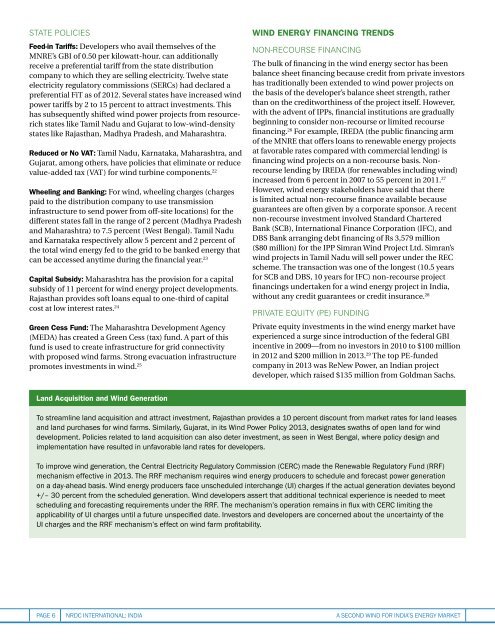India’s National Wind Energy Mission
Shakti Sustainable Energy Foundation has undertaken a study to identify such mechanisms that can support India’s national wind energy mission. Their report highlighted several financing policies, instruments and mechanisms to strengthen India’s wind energy sector. See more at: http://shaktifoundation.in/report/second-wind-indias-energy-market-financing-mechanisms-support-indias-national-wind-energy-mission/
Shakti Sustainable Energy Foundation has undertaken a study to identify such mechanisms that can support India’s national wind energy mission. Their report highlighted several financing policies, instruments and mechanisms to strengthen India’s wind energy sector. See more at: http://shaktifoundation.in/report/second-wind-indias-energy-market-financing-mechanisms-support-indias-national-wind-energy-mission/
You also want an ePaper? Increase the reach of your titles
YUMPU automatically turns print PDFs into web optimized ePapers that Google loves.
State Policies<br />
Feed-in Tariffs: Developers who avail themselves of the<br />
MNRE’s GBI of 0.50 per kilowatt-hour. can additionally<br />
receive a preferential tariff from the state distribution<br />
company to which they are selling electricity. Twelve state<br />
electricity regulatory commissions (SERCs) had declared a<br />
preferential FiT as of 2012. Several states have increased wind<br />
power tariffs by 2 to 15 percent to attract investments. This<br />
has subsequently shifted wind power projects from resourcerich<br />
states like Tamil Nadu and Gujarat to low-wind-density<br />
states like Rajasthan, Madhya Pradesh, and Maharashtra.<br />
Reduced or No VAT: Tamil Nadu, Karnataka, Maharashtra, and<br />
Gujarat, among others, have policies that eliminate or reduce<br />
value-added tax (VAT) for wind turbine components. 22<br />
Wheeling and Banking: For wind, wheeling charges (charges<br />
paid to the distribution company to use transmission<br />
infrastructure to send power from off-site locations) for the<br />
different states fall in the range of 2 percent (Madhya Pradesh<br />
and Maharashtra) to 7.5 percent (West Bengal). Tamil Nadu<br />
and Karnataka respectively allow 5 percent and 2 percent of<br />
the total wind energy fed to the grid to be banked energy that<br />
can be accessed anytime during the financial year. 23<br />
Capital Subsidy: Maharashtra has the provision for a capital<br />
subsidy of 11 percent for wind energy project developments.<br />
Rajasthan provides soft loans equal to one-third of capital<br />
cost at low interest rates. 24<br />
Green Cess Fund: The Maharashtra Development Agency<br />
(MEDA) has created a Green Cess (tax) fund. A part of this<br />
fund is used to create infrastructure for grid connectivity<br />
with proposed wind farms. Strong evacuation infrastructure<br />
promotes investments in wind. 25<br />
<strong>Wind</strong> <strong>Energy</strong> Financing Trends<br />
Non-recourse Financing<br />
The bulk of financing in the wind energy sector has been<br />
balance sheet financing because credit from private investors<br />
has traditionally been extended to wind power projects on<br />
the basis of the developer’s balance sheet strength, rather<br />
than on the creditworthiness of the project itself. However,<br />
with the advent of IPPs, financial institutions are gradually<br />
beginning to consider non-recourse or limited recourse<br />
financing. 26 For example, IREDA (the public financing arm<br />
of the MNRE that offers loans to renewable energy projects<br />
at favorable rates compared with commercial lending) is<br />
financing wind projects on a non-recourse basis. Nonrecourse<br />
lending by IREDA (for renewables including wind)<br />
increased from 6 percent in 2007 to 55 percent in 2011. 27<br />
However, wind energy stakeholders have said that there<br />
is limited actual non-recourse finance available because<br />
guarantees are often given by a corporate sponsor. A recent<br />
non-recourse investment involved Standard Chartered<br />
Bank (SCB), International Finance Corporation (IFC), and<br />
DBS Bank arranging debt financing of Rs 3,579 million<br />
($80 million) for the IPP Simran <strong>Wind</strong> Project Ltd. Simran’s<br />
wind projects in Tamil Nadu will sell power under the REC<br />
scheme. The transaction was one of the longest (10.5 years<br />
for SCB and DBS, 10 years for IFC) non-recourse project<br />
financings undertaken for a wind energy project in India,<br />
without any credit guarantees or credit insurance. 28<br />
Private Equity (PE) Funding<br />
Private equity investments in the wind energy market have<br />
experienced a surge since introduction of the federal GBI<br />
incentive in 2009—from no investors in 2010 to $100 million<br />
in 2012 and $200 million in 2013. 29 The top PE-funded<br />
company in 2013 was ReNew Power, an Indian project<br />
developer, which raised $135 million from Goldman Sachs.<br />
Land Acquisition and <strong>Wind</strong> Generation<br />
To streamline land acquisition and attract investment, Rajasthan provides a 10 percent discount from market rates for land leases<br />
and land purchases for wind farms. Similarly, Gujarat, in its <strong>Wind</strong> Power Policy 2013, designates swaths of open land for wind<br />
development. Policies related to land acquisition can also deter investment, as seen in West Bengal, where policy design and<br />
implementation have resulted in unfavorable land rates for developers.<br />
To improve wind generation, the Central Electricity Regulatory Commission (CERC) made the Renewable Regulatory Fund (RRF)<br />
mechanism effective in 2013. The RRF mechanism requires wind energy producers to schedule and forecast power generation<br />
on a day-ahead basis. <strong>Wind</strong> energy producers face unscheduled interchange (UI) charges if the actual generation deviates beyond<br />
+/– 30 percent from the scheduled generation. <strong>Wind</strong> developers assert that additional technical experience is needed to meet<br />
scheduling and forecasting requirements under the RRF. The mechanism’s operation remains in flux with CERC limiting the<br />
applicability of UI charges until a future unspecified date. Investors and developers are concerned about the uncertainty of the<br />
UI charges and the RRF mechanism’s effect on wind farm profitability.<br />
page 6<br />
NRDC international: INDIA<br />
A Second <strong>Wind</strong> for <strong>India’s</strong> <strong>Energy</strong> Market

















